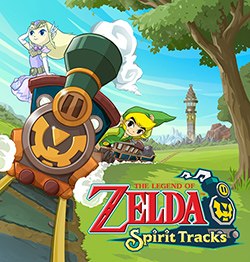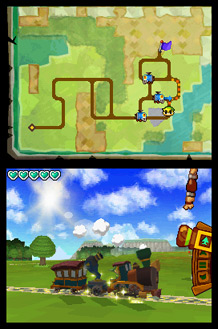The Legend of Zelda: Spirit Tracks is the fifteenth installment of Nintendo's The Legend of Zelda series. Developed by Nintendo for the Nintendo DS handheld game console, it was released worldwide throughout December 2009 after Nintendo president Satoru Iwata announced the game at the 2009 Game Developers Conference.
is the fifteenth installment of Nintendo's The Legend of Zelda series. Developed by Nintendo for the Nintendo DS handheld game console, it was released worldwide throughout December 2009 after Nintendo president Satoru Iwata announced the game at the 2009 Game Developers Conference.
The game features a cel-shaded art style similar to that of The Legend of Zelda: The Wind Waker and The Legend of Zelda: Phantom Hourglass. the protagonist of Spirit Tracks, travels across the game's overworld using a cannon-equipped steam train much like the steamboat in Phantom Hourglass. The player is also able to control Phantoms, one of the more difficult enemies from Phantom Hourglass, and play an instrument called the Spirit Flute.
Gameplay
Spirit Tracks continues its style of game play from The Legend of Zelda: Phantom Hourglass, in which players use the stylus to control Link and use his assortment of weapons, items, and vehicle albeit with a few game play tweaks. The game is divided into an overworld, which Link traverses using the Spirit Tracks, and towns and dungeons which he travels by foot. The player alternates between moving about the overworld and exploring towns and dungeons in order to complete the game's main story, but may opt to take in side quests for further rewards. In both the overworld and in dungeons, the player is able to make notes on their current map as an aid in puzzle solving or further reference; for example, some puzzles require the player to find the spot where two statues' gazes intersect to find a specific treasure or dungeon.
On the overworld, Link is able to direct his train across the land, with the ability to control speed and forward or reverse direction, to turn at track intersections, and to blow the train's whistle to scare animals off the tracks. The player is able to automatically set a route for the train by drawing on the Spirit Track map, though not all locations are immediately available in this fashion. Later, Link is given a cannon that he can use to defend the train from attacks. Link also eventually gains a cargo car, which he can use to move goods from one town to another for additional bonuses. Some missions require Link to transport a passenger along the rails, and require the player to keep the passenger happy by following the signs along the side of the tracks, such as slowing down for tight turns or blowing the train's whistle, in order to successfully complete the mission. As the game progresses, the player opens more of the map, and encounters special warp points, activated by blowing the train's whistle, to move quickly between map sections.
In towns and dungeons, the player controls Link using the stylus, directing the character where to go. The stylus is also used to perform attacks and dodges and to select special items, such as bombs and a boomerang, used for combat and puzzle solving in order to progress further in the game. Certain items, in particular Zelda's pan flute, require the player to blow into the DS's microphone to simulate playing of the instrument. In the case of the pan flute, successfully completing songs can unlock new songs with magical properties, reveal hidden secrets, heal Link, or restore more of the Spirit Tracks. In certain dungeons, the ethereal Zelda can inhabit Phantom Guardians that patrol the levels after Link successfully attacks them. Once Zelda has possessed one of these, the player can direct the Phantom along a stylus-drawn path or to attack a creature, to carry Link safely across dangerous fields, or to simply follow Link. Several puzzles of the game require the player to manipulate Link and the Zelda-possessed Phantom along different paths to complete a goal, switch back and forth between control of the two allies. In towns, the player can have Link speak to its residents, buy goods at local stores, and learn more about where to travel to next.
Unlike The Legend of Zelda: Phantom Hourglass, Spirit Tracks does not feature Nintendo Wi-Fi Connection multiplayer. However, up to four players can play via DS Download Play, using only one game card, and one game system per player. This multiplayer mode is non-canonical, as all four players play as different Links, each with different-colored tunics (a style used in The Legend of Zelda: Four Swords Adventures). Each player attempts to collect as many Force Gems (of varying sizes, value and number) as possible within a set time limit. Opposition includes the other players; a varying number of non-partisan Phantoms, who will attack any player on sight; and the play stages themselves, with environmental hazards. Results of the most recent game played will show up on a bulletin in most in-game towns and cities. "Tag Mode", an item trading system, is also available between local players.
Spirit Tracks features major changes from Phantom Hourglass. While Phantom Hourglass required the player to traverse through the entire dungeon again and again, Spirit Tracks uses a spiral staircase to access upper floors (although the game still features a central dungeon). Also unlike Phantom Hourglass is the lack of the "curse" that the hourglass protected Link from for a limited amount of time (although the safe zones are still used to hide from the phantoms).
http://www.filesonic.in/file/446859131/4527
http://www.fileserve.com/file/xufE8kr
http://www.wupload.com/file/20104030/4527.zip
http://www.megaupload.com/?d=GTI2H384









0 comments:
Post a Comment